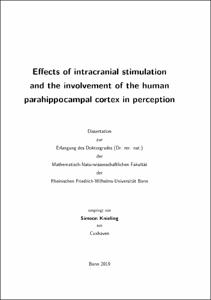Effects of intracranial stimulation and the involvement of the human parahippocampal cortex in perception

Effects of intracranial stimulation and the involvement of the human parahippocampal cortex in perception

| dc.contributor.advisor | Mormann, Florian | |
| dc.contributor.author | Knieling, Simeon | |
| dc.date.accessioned | 2020-04-26T23:11:37Z | |
| dc.date.available | 2020-04-26T23:11:37Z | |
| dc.date.issued | 04.10.2019 | |
| dc.identifier.uri | https://hdl.handle.net/20.500.11811/8077 | |
| dc.description.abstract | How the human brain translates photons hitting the retina into conscious perception remains an open question. Throughout the medial temporal lobe (MTL), there are neurons (called concept cells) that change their firing rate when that neuron's preferred concept, e.g., a specific person or object, is seen. The firing rate of concept cells is correlated with perception. Nevertheless, it remains unclear whether or to what extent concept cells are involved in perceptogenesis, i.e., the creation of conscious percepts. Inferring from studies in monkeys, concept-specific neurons involved in perceptogenesis would be expected along the ventral and dorsal stream of visual processing (also called the what and where pathway, respectively). Various regions that are part of the dorsal stream are connected to the parahippocampal cortex (PHC), a region within the MTL. Compared to other MTL regions, lower selectivity, the absence of multimodal responses, and especially the shorter response latencies do not exclude an involvement of the PHC in perceptogenesis. In fact, damage to the parahippocampal place area (PPA, a part of the PHC) results in topographical disorientation. The goal of this thesis is to test the involvement of the PHC in perception by using electrical stimulation during a forced-choice categorization task involving landscapes versus animals. First, we determined effective parameters for intracranial stimulation of brain tissue in epilepsy patients implanted with depth-electrodes for seizure monitoring. We investigated the effects of amplitude, phase width, frequency, and pulse-train duration on neuronal firing, the local field potential (LFP), and behavioral responses to evoked percepts. Frequency and charge per phase were the most influential parameters on all three signals. Both parameters showed a positive effect on event-related potentials (ERPs) in the LFP. Higher frequencies (especially around 200 Hz) lead to a short-term inhibition of neuronal firing, while higher charge per phase can have an inhibitory or excitatory effect on neuronal firing. All parameters had a positive effect on the reports of evoked percepts; on reports of phosphenes in response to stimulating close to the optic radiation as well as on reports of auditory verbal hallucinations in response to stimulating Heschl's gyrus. Using functional magnetic resonance imaging (fMRI), we found that the PPA, i.e., the part of the PHC that is most selective towards images of landscapes, is rather small (up to 1‰ of total brain volume per hemisphere) with varying degrees of hemispheric laterality. Stimulating the PHC outside of the PPA - using a 100 ms high-frequency pulse train delivered at the natural response latency of the PHC - had no effect on categorizing landscapes. However, stimulating inside the PPA, close to the peak activation of the fMRI cluster, resulted in a 7% to 10% increase in landscape responses to ambiguous stimuli. Furthermore, stimulating the PPA also led to an increase in behavioral response time, especially to images with a predominant landscape component. None of our patients reported visual hallucinations of places or scenes in response to our stimulation protocols. Our data suggests that the PPA is involved in the perceptogenesis of landscapes at a stage that does not reach awareness, while the rest of the PHC is unlikely to be involved in perceptogenesis, at least not as it pertains to the perception of landscapes or animals. We also developed an online spike sorting algorithm and an adaptive screening procedure for concept cells to pave the way for new paradigms involving informed feedback. | en |
| dc.language.iso | eng | |
| dc.rights | In Copyright | |
| dc.rights.uri | http://rightsstatements.org/vocab/InC/1.0/ | |
| dc.subject | Mensch | |
| dc.subject | Gehirn | |
| dc.subject | Elektrophysiologie | |
| dc.subject | Elektrische Stimulation | |
| dc.subject | Wahrnehmung | |
| dc.subject | Medialer Temporallappen | |
| dc.subject | Gyrus parahippocampalis | |
| dc.subject | Phosphene | |
| dc.subject | Gyri temporales transversi | |
| dc.subject | Auditorische Halluzinationen | |
| dc.subject | Human | |
| dc.subject | Brain | |
| dc.subject | Electrophysiology | |
| dc.subject | Intracranial Stimulation | |
| dc.subject | Perception | |
| dc.subject | Medial Temporal Lobe | |
| dc.subject | Parahippocampal Cortex | |
| dc.subject | Parahippocampal Place Area | |
| dc.subject | Phosphenes | |
| dc.subject | Heschl's Gyrus | |
| dc.subject | Auditory Verbal Hallucinations | |
| dc.subject.ddc | 500 Naturwissenschaften | |
| dc.subject.ddc | 570 Biowissenschaften, Biologie | |
| dc.subject.ddc | 610 Medizin, Gesundheit | |
| dc.title | Effects of intracranial stimulation and the involvement of the human parahippocampal cortex in perception | |
| dc.type | Dissertation oder Habilitation | |
| dc.publisher.name | Universitäts- und Landesbibliothek Bonn | |
| dc.publisher.location | Bonn | |
| dc.rights.accessRights | openAccess | |
| dc.identifier.urn | https://nbn-resolving.org/urn:nbn:de:hbz:5n-55862 | |
| ulbbn.pubtype | Erstveröffentlichung | |
| ulbbnediss.affiliation.name | Rheinische Friedrich-Wilhelms-Universität Bonn | |
| ulbbnediss.affiliation.location | Bonn | |
| ulbbnediss.thesis.level | Dissertation | |
| ulbbnediss.dissID | 5586 | |
| ulbbnediss.date.accepted | 16.09.2019 | |
| ulbbnediss.institute | Medizinische Fakultät / Kliniken : Klinik für Epileptologie | |
| ulbbnediss.fakultaet | Mathematisch-Naturwissenschaftliche Fakultät | |
| dc.contributor.coReferee | Bleckmann, Horst |
Files in this item
This item appears in the following Collection(s)
-
E-Dissertationen (4413)




